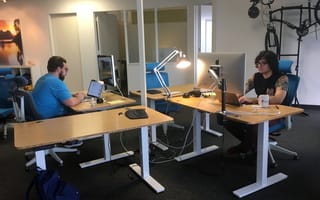
Two people write every single strand of code that Frontside developers output — one works for Frontside and the other with the company that hired them to develop the software.
In the engineering world, this agile software technique is called paired programming, and it’s one of the Austin-based firm’s core practices. It allows for Frontside’s client developers to ask questions in real-time and see the Frontside team’s response. It also allows the two parties to virtually observe and work side-by-side throughout the project.
The result: A smooth transition when the company takes over the project from Frontside.
“We haven’t done our job unless our clients can maintain the software that we’ve built with them with their own developers,” said Charles Lowell, Frontside CEO and founder. “Our goal is to deploy production on the very first day of the project.”
Lowell said this is often why companies elect to work with Frontside.
“We’re selected for our approach more than anything,” he said. “Clients know they are getting an application that will be maintainable and not an asset liability for years to come.”
While successful in practice, this environment is one in which not all engineers thrive — leading to a particularly in-depth interview process when Frontside is bringing on new developers, Lowell said.
“This collaborative culture starts at the hiring level for Frontside, and it involves finding the right combination of talent and personality fit,” said Lowell. “We have to identify the engineers who want to work in a collaborative style versus those that don’t.”
He and his team do this by setting up two working sessions with developer candidates lasting one to two hours each. For the first session, candidates are invited to bring in a project that they’ve been working on. Then the Frontside team will work alongside candidates on their projects.
“During this first session, we’re looking for what it is that they can teach us,” Lowell said. “We give them the opportunity to be the expert.”
Some of the projects brought in by candidates have included a software engine that calculates Dungeons and Dragons scores as well as an app that tracks paleolithic artifacts.
“If they are the subject matter expert, then this first session sets them up for us to see the best of them,” said Lowell. “They get to see what it looks like when we are learning from them.”
Then for the second session, Frontside flips it — allowing one of their developers to lead a collaborative session with the candidate using one of Frontside’s open source projects.
“Now we get to see how they follow as opposed to lead,” Lowell explained.
The final interview consists of a full paid day of work that has the candidate contributing to a real client project, as if they are a Frontside employee.
“We wanted to re-create a condensed experience of what it would actually be like to work with this person in a high fidelity environment,” said Lowell.
Since adopting this interviewing process a few years ago, Frontside hasn’t had a “process failure,” Lowell said.
“Before we put in these controls, we had some hiring misses,” said Lowell. “But that doesn’t bother me. What bothers me is the people we missed out on because we didn’t give them the chance to put their best foot forward.”






